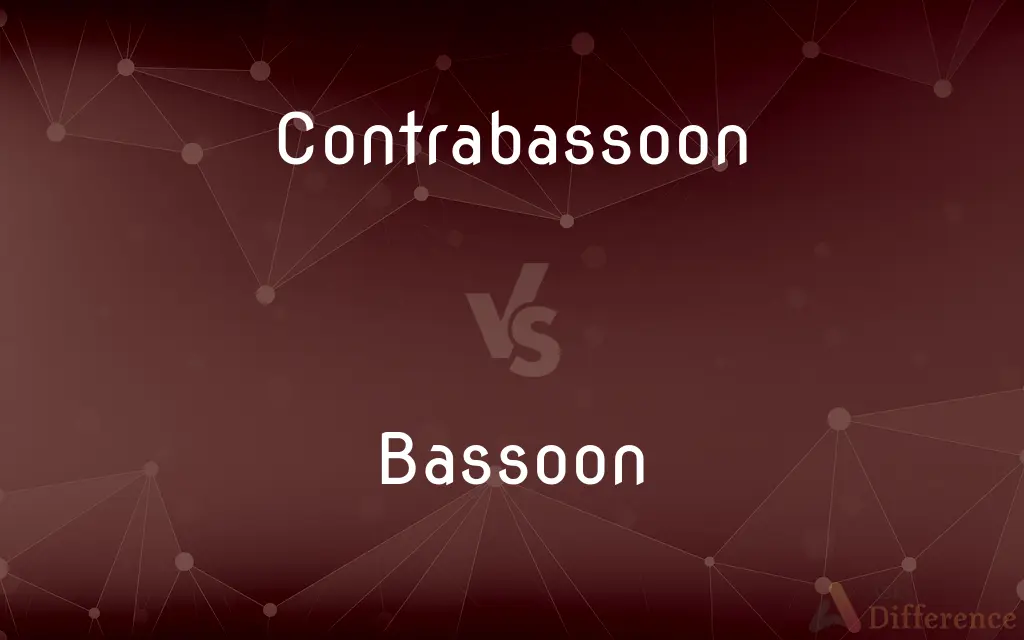Contrabassoon vs. Bassoon — What's the Difference?
By Urooj Arif & Fiza Rafique — Updated on April 8, 2024
The contrabassoon, with its deeper tone, complements the bassoon, which has a higher pitch and versatility in orchestras.

Difference Between Contrabassoon and Bassoon
Table of Contents
ADVERTISEMENT
Key Differences
The contrabassoon is known for its deep, resonant sound, often playing an octave lower than the bassoon, making it essential in providing foundational bass lines in orchestral and chamber music. On the other hand, the bassoon offers a broader range of notes and is more versatile, frequently taking on both melodic and harmonic roles within ensembles.
While the contrabassoon is characterized by its larger size and more complex key system, which contributes to its unique sound, the bassoon is smaller and slightly simpler in design, making it somewhat more accessible to players in terms of physical handling and learning curve.
The contrabassoon, due to its size and role in an ensemble, is less commonly played and requires specialized techniques to master its extended lower register. Whereas the bassoon, being more prevalent in orchestras and smaller ensembles, provides musicians with more opportunities for solo performances and a wider repertoire.
In terms of repertoire, the contrabassoon is typically used to bolster the bass section, rarely receiving solo passages due to its lower register and specific timbre. The bassoon, however, enjoys a rich solo repertoire that showcases its expressive capabilities and agility across a wide range of musical genres.
The contrabassoon and bassoon, while both double reed instruments, differ significantly in their contribution to musical textures. The contrabassoon often acts as a foundation, enriching the ensemble's sound with depth, while the bassoon frequently plays a more dynamic and variable role, moving between harmony, melody, and rhythm.
ADVERTISEMENT
Comparison Chart
Pitch Range
Plays an octave lower than the bassoon
Higher pitch, versatile range
Size and Design
Larger, with a more complex key system
Smaller and simpler in design
Role in Ensembles
Provides foundational bass lines, less solo work
More versatile, with both solo and ensemble roles
Repertoire
Limited solo repertoire, focused on ensemble depth
Rich solo repertoire and varied ensemble roles
Learning Curve
Requires specialized techniques for its register
More accessible, with a broader learning scope
Compare with Definitions
Contrabassoon
Deep-toned woodwind.
The contrabassoon's deep tones are essential in symphonic bands.
Bassoon
Smaller and simpler.
Compared to the contrabassoon, the bassoon is more accessible for beginners.
Contrabassoon
Large and complex.
The contrabassoon stands out due to its large size and complex mechanism.
Bassoon
Broad repertoire.
The bassoon enjoys a broad repertoire that spans classical to contemporary music.
Contrabassoon
Specialized technique.
Mastering the contrabassoon requires learning specialized breathing techniques.
Bassoon
Versatile woodwind.
The bassoon adds a rich, versatile sound to any ensemble.
Contrabassoon
Foundational bass role.
Its role in ensembles is to provide a deep, foundational bass.
Bassoon
Higher pitch.
Its higher pitch allows the bassoon to play both melodic and harmonic roles.
Contrabassoon
Octave lower than bassoon.
In the orchestra, the contrabassoon plays notes an octave lower than the bassoon.
Bassoon
Solo and ensemble roles.
Bassoonists often have opportunities for solo performances in addition to ensemble playing.
Contrabassoon
The contrabassoon, also known as the double bassoon, is a larger version of the bassoon, sounding an octave lower. Its technique is similar to its smaller cousin, with a few notable differences.
Bassoon
The bassoon is a woodwind instrument in the double reed family, which has a tenor and bass sound. It is composed of six pieces, and is usually made of wood or synthetic plastic.
Contrabassoon
The largest and lowest pitched of the double-reed wind instruments, sounding an octave below the bassoon. Also called double bassoon.
Bassoon
A bass woodwind instrument of the oboe family, with a doubled-back tube over four feet long, played with a double reed.
Contrabassoon
(musical instruments) A larger version of the bassoon sounding one octave lower, having a technique similar to the bassoon but offers more resistance in every way.
Bassoon
A low-pitched woodwind instrument with a double reed, having a long wooden body attached to a U-shaped lateral tube that leads to the mouthpiece. The range of this instrument is typically two octaves lower than that of the oboe.
Contrabassoon
The bassoon that is the largest instrument in the oboe family
Bassoon
A musical instrument in the woodwind family, having a double reed and playing in the tenor and bass ranges.
Bassoon
To play the bassoon.
Bassoon
To make a bassoon-like sound.
Bassoon
A wind instrument of the double reed kind, furnished with holes, which are stopped by the fingers, and by keys, as in flutes. It forms the natural bass to the oboe, clarinet, etc.
Bassoon
A double-reed instrument; the tenor of the oboe family
Common Curiosities
How do the roles of the contrabassoon and bassoon differ in an orchestra?
The contrabassoon primarily supports the bass line, whereas the bassoon plays more varied roles including melody and harmony.
Can the same music be played on both the contrabassoon and the bassoon?
While they share similarities, their different pitch ranges and timbres usually mean music is specifically arranged for each.
Why is the bassoon more common in solo performances?
Its broader pitch range and expressive capabilities make the bassoon more suitable for solo repertoire.
What is the main difference between a contrabassoon and a bassoon?
The main difference lies in their pitch range and size; the contrabassoon plays an octave lower and is larger than the bassoon.
How do beginners choose between the contrabassoon and the bassoon?
Beginners often start with the bassoon due to its more manageable size and broader learning materials.
Do contrabassoon and bassoon players use the same reeds?
No, they use differently sized reeds appropriate to their respective instrument's mouthpiece and sound production needs.
Is the contrabassoon harder to play than the bassoon?
Due to its size and the technique required for its lower register, the contrabassoon can be more challenging to master.
What's the learning curve like for the bassoon?
The bassoon has a steep learning curve due to its complex fingering and breath control requirements.
Is it common for bassoonists to also play the contrabassoon?
Some bassoonists do learn both to increase their versatility and employment opportunities.
Are contrabassoonists in high demand?
Yes, due to its unique role in ensembles, skilled contrabassoonists are valuable in orchestras.
Are there modern compositions for the contrabassoon?
Yes, contemporary composers are increasingly exploring the contrabassoon's capabilities, expanding its repertoire.
Can the contrabassoon be used as a solo instrument?
While rare, there are solo pieces for contrabassoon, showcasing its unique sound in a solo context.
How does the size of the contrabassoon affect its playability?
Its large size and length require specific techniques and physical stamina, especially for controlling breath and finger movements.
What genres of music feature the contrabassoon?
The contrabassoon is primarily found in classical music, especially in symphonic and operatic works.
How does the sound of the contrabassoon enhance an orchestra?
It provides depth and resonance, enriching the orchestra's overall sound with its deep bass tones.
Share Your Discovery

Previous Comparison
Ailing vs. Sick
Next Comparison
Plasmolysis vs. TurgidityAuthor Spotlight
Written by
Urooj ArifUrooj is a skilled content writer at Ask Difference, known for her exceptional ability to simplify complex topics into engaging and informative content. With a passion for research and a flair for clear, concise writing, she consistently delivers articles that resonate with our diverse audience.
Co-written by
Fiza RafiqueFiza Rafique is a skilled content writer at AskDifference.com, where she meticulously refines and enhances written pieces. Drawing from her vast editorial expertise, Fiza ensures clarity, accuracy, and precision in every article. Passionate about language, she continually seeks to elevate the quality of content for readers worldwide.














































